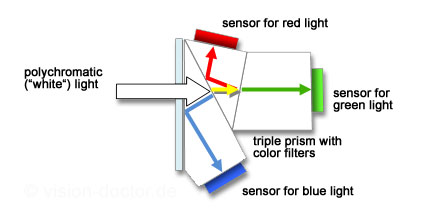Colour line scan cameras
Colour inspection is also possible when using a line scan camera. Especially in the field of print image inspection and sometimes also in surface inspection it is particularly important to have colour information available for the evaluation, too. The user can select from different key technologies in sensor design:
Single line with RGB triple
The simplest, cheapest possibility to capture colour information using a line scan camera is the use of one single colour line.
 |
The monochrome sensor is equipped with an RGB pattern of colour filters, similar to an area scan sensor. In this way either only red, green or blue is passed to the respective pixel, the other colours are absorbed. As an RGB colour value is supposed to be available for each pixel in the image, the remaining colours must be interpolated from the neighbouring pixels in order to obtain the full colour information of the image. It is also suitable for non-linear motion capture, as the line is captured simultaneously.
Disadvantages of this technology are the reduced resolution of the camera due to the Bayer pattern, possible Bayer interpolation artefacts, worse colour resolution and lower brightness sensitivity due to the colour mosaic.
Dual line
In order to optimise the single-line principle, a second, completely green-sensitive line is added.
 |
Especially the sensitivity to light of the camera can be further enhanced in this way, with a still simple sensor. Disadvantages of this technology are comparable to the single-line version, with a better overall resolution and sensitivity performance.
Trilinear sensor
A single sensor is equipped with three lines next to each other, which are sensitive to red, green and blue, respectively. The colour line scan camera now has the maximum sensitivity with full resolution and generates very good colour images.
 |
The disadvantage of this technology is the distance between the individual lines. In case of high-quality cameras, it is approximately three times the pixel size. This can be adverse for the image capture if the motion of the conveyor is not linear, since the capture of the lines is delayed in time in order to compensate the distance in between. Edge artefacts are possible.
3-CCD/CMOS lines with prism
An integrated beam splitter with a triple prism spreads the incident light onto three physically separated sensors which either absorb red, green or blue light.
The advantage of this technology is the high quality of the colour images with full physical resolution, as the sensors are exposed varyingly long and can be corrected. A low production tolerance and exact alignment of prisms and sensors is important in order to capture the image on three sensors exact to the sub-pixel. Even non-linear motion can be captured using this technology as the sensor detection occurs simultaneously.
Design of a 3ccd camera
 |
Disadvantages of this technology are mostly the somewhat lower temperature applications (sensor and prism alignment suffers from high temperatures), the higher price and use of high-quality optics.








